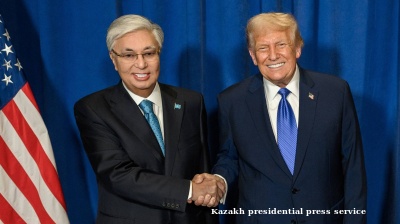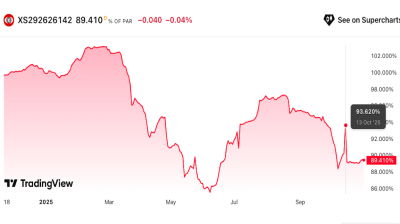Turkey’s official consumer price index (CPI) inflation moved up to 54% y/y in February, marking the highest level recorded since the 65% posted in March 2002. It increased from 49% y/y in January. The data was provided by Turkey’s national statistical institute (TUIK, or TurkStat) in a release published on March 3.
At 54.4%, Turkey has overtaken Argentina for high inflation. Turkey’s next rival in the global inflation league is Suriname. Its inflation stands at 61.5%, ranking it seventh worldwide.
Also on March 3, ENAG, an independent inflation research group in Istanbul, said that its calculation was that inflation in Turkey rose to 124% y/y in February from 115% y/y in January.
The official figure given for February means that Turkey’s official inflation rate now sits 40pp above the central bank’s policy rate of 14%. The rate determined by ENAG is 109pp above the benchmark.
Official producer price index (PPI) inflation, meanwhile, entered three-digit territory for the first time since March 1995, when it posted 144% y/y.
The February figure for official PPI inflation was 105% y/y, up from 94% y/y in January, TUIK separately announced.
On January 27, the central bank’s quarterly inflation report implied that official CPI inflation was seen as peaking at around 55% y/y in May.
The market expectation at that point was in line with that of the central bank. However, following the latest shock in commodity prices, the market expectation for the May peak moved up to the 60%s. Brent oil on March 3 saw $119.

Mainstream forecasts for the likely trajectory of Turkey’s official inflation reckon without the Turkish lira (TRY) crashing again and commodity prices coming totally off the hinges.
It was on February 18 that Turkey’s monetary policy committee (MPC) kept the policy rate on hold at 14%.
On March 17, the MPC is scheduled to hold its next rates meeting. Currently, the market expectation is that it will again hold the benchmark.
On April 4, TUIK and ENAG will release their inflation figures for March.
Turkey’s unorthodox monetary policy remains subject to widespread condemnation and disbelief. There is no visible sign of foreign interest in the lira.
In mid-February, monetary conditions on the market again entered into an easing trend. Net lira creation via loans reached TRY123bn ($870.8mn) in February, the highest figure recorded since the all-time high TRY141bn in April 2020.


The Turkish government has taken steps to further boost the loan growth.
Despite the easing monetary conditions, economic activity has not responded positively. Europe has also endured a slowdown since the beginning of 2022.
The Ukraine war is an undeniable factor at the moment. Prior to February 24, when the Putin regime launched its full-blown invasion of Ukraine, the expectation was for a limited invasion in the Donbas region, where there was already conflict with proxies of Russia.
However, since February 24, we have entered into a new chapter in history. Currently, in response to the war, the West has regrouped and is waging a full-blown campaign to destroy the Russian economy.
Given the extent of sanctions already imposed on Moscow, the only possible escalations from here are an absolute ban on Russian gas and oil exports or an absolute ban on Russia’s access to the global SWIFT payments system used by banks.
So far, Russia’s energy imports and Russian access to the SWIFT system have only been partially hit. The most sensational move by Western powers was the blocking of the Russian central bank’s international assets and the cutting of its access to the global financial system. That means Russia’s international reserves are mostly useless as things stand.
There is a real war pitching one sovereign state against another and Turkey cannot escape the heat. For instance, Black Sea trade has simply stopped.
On the short-term horizon, Turkey has enough sunflower oil stocks for around one month while 15-16 vessels loaded with oil are currently stranded at ports in Ukraine and Russia, according to Turkey’s oil industrialists association. It outlined the concerns on March 2 in a written letter sent to the trade ministry.
On March 2, Turkey’s grain board TMO held its previously announced tender to import 435,000 tonnes of wheat.

Initial bids in the tender shared by @sunseedman.
Due to booming prices, TMO could only book 370,000 tonnes at an average price of $445 per tonne (table below), suggesting a 28% jump from $348 on January 18, when the TMO bought 335,000 tonnes of wheat.

On March 3, the TMO cancelled 75,000 tonnes of booked bids, which were priced higher than $451.7 per tonne, according to @sunseedman.
As a result, the authority could buy only 295,000 tonnes at an average price of $435 per tonne, still 25% higher than the average price obtained in the previous tender held on January 18.


On March 3, Turkish President Recep Tayyip Erdogan stated in a decree that Turkey would not demand the usual required certificates and documents for agricultural imports from Ukraine and for the transit trade of Ukrainian agricultural products.
There are those in the Erdogan regime who have benefited from the Syrian War via shadow and illegal trading. The Turkish economy also enjoyed the dropping crumbs of the “trade” activities in question in the initial years of the war.
It is too early to form conclusions as to the what the direct impacts on the Turkish economy of the Ukraine conflict will be, although indirect effects seen in booming commodity prices are currently undeniable.
At the moment, Russians are still permitted to fly to Turkey, while most countries have closed their airspace to Russian civilian flights. How such issues will evolve by the beginning of the tourism season in April, whether many Russians will have the wherewithal and spirit to go on an overseas holiday and whether Turkey will remain a safe destination are questions to be answered further down the road.
When it comes to the political implications of the Ukraine Russia showdown, the main envisaged scenario still suggests that Erdogan will not be smashed between the US, once more seen as “the West”, and the Putin regime.
In the Western media, the Montreux Convention regulating the passage of vessels including warships to the Black Sea and the combat drones of Erdogan’s younger son-in-law are overdone topics once again. The main idea is always that all possible countries should fight against Russia.
However, Erdogan has not notched up such a conflict. The closest he came was in November 2015 when a Russian jet was downed by a Turkish jet after a claimed Turkish border breach. But by June 2016, Erdogan was writing a letter to Vladimir Putin to apologise.
So far, Erdogan has managed to sit on the fence between the West with Ukraine and Russia. Where things go from here is by no means clear.
In the unfolding warfare, Ukraine was still resisting as of March 3. See how the Russians are painting eastern Ukraine red on the live map here.
When it comes to the lira, the Erdogan regime has been struggling to keep the USD/TRY pair below the 14-level since February 24. It has still not lost control, but it has been burning through the reserves again, sending high volumes up in smoke.
Turkey’s banking watchdog BDDK has stopped releasing daily data on the FX-guaranteed lira deposit scheme. The regulator now only provides weekly data. Breakdowns on lira deposit conversions and FX deposit conversions are not available.

The FX deposits share stood at 58.7% as of February 25 while deposits under the FX-guaranteed scheme were at 8.8%. Overall dollarisation stood at a fresh record high of 67.5%. Chart by @Dr_OrhanKaraca.
Presently, it is unknown how much is flowing into the central bank’s account from the deposit scheme and exporters.
The central bank’s net FX position (net reserves minus the Treasury’s FX account at the central bank), by @e507.
Turkey’s trade deficit remained high at $8bn in February after $10bn was registered for January. March will also deliver a high trade gap.
Five-year credit default swaps (CDS) on Turkey have been hovering in the 500s.
In global markets, the USD index (DXY) rose into the 97s, while the yield on 10-year US Treasury papers fell to the 1.80s.
On March 16, the Fed’s open market committee will announce the results of its next meeting along with updated projections from the governors.
Prior to the Ukraine war, a 50bp rate hike was already priced in. However, a 25bp is expected now, thanks to the conflict.
On March 2, Fed chair Jerome Powell raised concerns over “Ukraine-related risks” but he confirmed that the policy rate would be hiked at the March meeting.
Also because of the war, expectations for a European rate hike have been pushed into 2023. So no rate hike for Europe this year.
In Turkey, the war overwhelms anything else in the media right now. Erdogan will have a free hand until the dust settles. The still floundering opposition, meanwhile, will be holding some more meetings.
Right across the opposition parties you find figures carrying big baggage packed with crimes from across their decades-long political careers. Their average age is about 70. There is only one woman of prominence. She served as interior minister during Turkey’s bloody 90s.
Causality is important here. Turkish opposition figures have come together to share the booty since Erdogan has already lost the next election.
Still, Erdogan will come up with some surprises. With his election mode talents, he can easily destroy the losers seen among his competitors. However, even against an empty water bottle at the ballot box, he’d have no chance if an election was held right now. Such is the wretched state of the Turkish people.
Features

Washington has a new focus on a Caspian energy play
For most of the last three decades since winning independence, Central Asia has been a bit of a backwater. Not any more. The Trump administration is becoming more focused on Turkmenistan's vast gas reserves and can smell money and power there.

BOTAŞ and Turkey’s hub ambition: from “30-year dream” to cross-border reality
For Ankara, the symbolism is as important as the molecules: Turkey’s energy map is shifting from end-market to hub.

Indian bank deposits to grow steadily in FY26 amid liquidity boost
Deposit growth at Indian banks is projected to remain adequate in FY2025-26, supported by an improved liquidity environment and regulatory measures that are expected to sustain credit expansion of 11–12%




